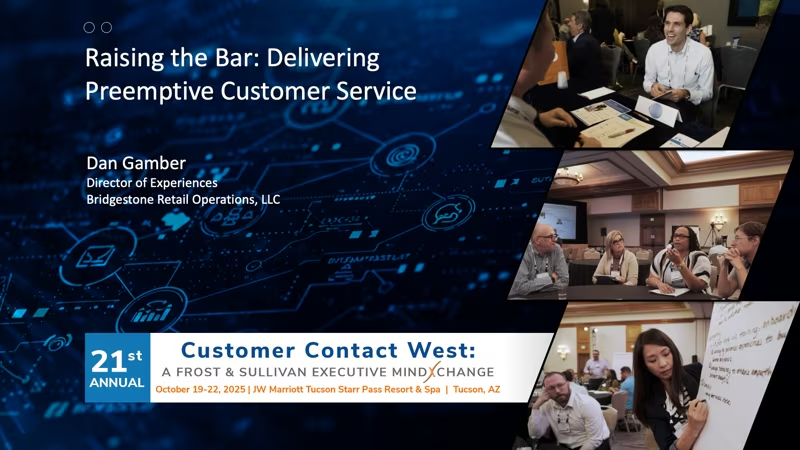Participants at the 18th Annual Customer Contact East: A Frost & Sullivan Executive MindXchange learned from exciting headliners, impressive panels and lively roundtable discussions. But few sessions were as solution-focused as THE FIX, Crowdsourcing Tactical Solutions to Our Most Vexing Challenges. Consisting of five themed brainstorming sessions, the experience allowed participants to crowdsource solutions to some of today’s most challenging customer service issues. Each group built upon the others, resulting in the informed and implementable “fixes” below:
1. The Fix on Customer Support in Times of Supply Chain Disruption
Hosted by Brian Gustin, Senior Director of Business Operations and Customer Engagement, Crocs, Inc.
Transparency and accountability are critical to today’s consumers. How your brand sets expectations pre‐purchase is as important as consistently communicating through the delivery process:
- Many consumers now have a low tolerance, and don’t accept “it’s Covid” or “its supply chain” generalizations like they may have at the start of the pandemic. Instead, they want empathy and ownership
- Set and manage expectations by giving as much visibility as possible to product delivery timelines. When possible, admit when you can’t meet demand before the sale
- If you can’t meet your promise, at least provide consistent, proactive communication of delays. Updates with no news are better than no updates
- Wherever possible, provide information to the upstream supply chain, but make sure your data is accurate
- When failures inevitably happen, don’t: pass the buck (“It’s our supplier’s fault”), or put an extra burden on the consumer to solve it themselves
- Consider designing key moments of transparency into your consumer’s journey. For example, the United Airlines app telling you when your luggage is scanned throughout its journey
Try shaping demand to in‐stock, ready to ship inventory:
- Companies need to consider ability to react with more real- time flexibility with marketing, on‐site sales and agent training
- Agility is more important than ever. How far can you plan in advance to anticipate delays or depleted stock?
- Can you offer alternative products or solutions? If you can’t recommend a substitute, the consumer may look for a competitor who can
- Be pragmatic when you design your product road maps. Ask: can we actually deliver what we’re promising?
- Brands that embrace the principles above will engender the most loyalty and increase repeat purchases
2. The Fix on Innovating Training, Learning, and Development
Hosted By: Michelle Norcross, Executive Director, Customer Care, the Avon Company
Challenge: Addressing the shift to virtual – how to keep employees engaged and enhance connectivity
Discussion/fixes:
- Going virtual added more challenges with facilitation due to issues with new technology and connectivity, including a need for chat monitoring, breakout sessions and more general facilitation
- Provide all employees with a webcam
- Many struggle with team members not wanting to be on camera. Some solutions include setting expectations up front, leveraging the camera time to build stronger personal relationships, engaging (if/when appropriate) team members’ family, pets, etc. in the conversation, etc. Strive to grow the relationship and support a ‘no judgement’ culture
Challenge: Retaining early hires until a full class can be ready to begin training
Discussion/fixes:
- Introduce self‐paced, recorded, interactive sessions to allow new hires to engage as soon as hired, instead of waiting until a full class is ready. This can help reduce attrition prior to start dates.
- Move from paper-based training (like slides) to system-based training like Lessonly, for example
Challenge: Improving attrition and time to proficiency
Discussion/fixes:
- Redesign your training around how your best agents execute
- Break up training into segments and put new employees on phones as quickly as possible
- Try to minimize length of training and the build‐up to taking those first calls. Many find that people do well in class and then implode when it all comes together taking calls.
- Consider segmenting training and letting new hires field routine calls early in training.
- Let a tenured team member handle systems and supporti, but allow the new hire to handle the conversation.
- Implement a virtual buddy system, pairing a new agent with a tenured agent
General discussion questions:
- How have we equipped our trainers to manage in this new normal?
Many trainers are comfortable and competent in an in‐person classroom setting, but don’t necessarily have the skills to excel in a virtual environment. Specific solutions were not identified, but thisit needs to be addressed. - How to adjust the skill sets we seek in our agent population now that we are in a virtual environment?
Soft skills are still critically important but you may need to look for people with core technical skill sets so they are able to set up and do basic troubleshooting of their home office equipment.
3. The Fix on Inclusivity and Accessibility
Hosted By: Vannessa LeBoss, Director, Connect Direct, Communication Service for the Deaf
Background:
- More than two million deaf people in the United States alone rely on American Sign Language (ASL) as their primary mode of communication
- ASL is NOT based on English- completely separate language. It is a 2nd or 3rd language for a large number of the deaf community
Current solution:
- The first all-deaf contact center in the world employs deaf and provides direct customer support to deaf callers through video IVR.
Problems and barriers:
- Lack of awareness abounds about the deaf community and what is “effective” communication (Not effective includes Video Relay Service, chat/text based options)
- There is a 70% un/under employment rate for the deaf/disabled community
Ideas and comments:
- Perception that hiring persons with a disability isn’t cost-effective. (excessive costs to employ individuals in order to provide “accommodation”)
- 1 in 4 deaf quit a job due to (perceived) discrimination
- Avoid isolation (hiring one or a few people that work in an environment with 500 seats does not create a conducive working environment)
- Evaluate your company culture
- Companies should establish DEI programs:
- That have SME’s in all aspects of disability (physical, cognitive, blind/vision, deaf/hard of hearing)
- With more than one “token” person to take care of all needs
- That look for ways to increase employment of people with disabilities in a cost-effective manner; found via: innovative technology, partnering with disability-focused organizations
- Tax credits many companies are unaware of for providing accessible services
- Research and learn tools to more easily communicate , including video and IVR
- Equality is not the same as Equitable. Strive for equitable communication, not “equal”
4. The Fix on Business Process Efficiency
Hosted By: Francoise Benoit-Betters, Vice President, Merchant Service, First American by Deluxe
Improve business process efficiency with:
- Bots, chat, short message service (SMS)
- Meeting customer needs and satisfying customers
- Understanding intents and answering quickly
- Offering Interactive Voice Response (IVR) self-serve options
Determine efficiency for metrics:
- Use scorecard – post all agents
- Call handle
- Not actual QA score
- Login time
- Incentive
- Make it a positive experience
- Keep agents to accountable breaks, lunch, keep open communication with team members
- Real time swap board
Define efficient versus effective:
- 50%-100% attrition
- Human and AI work together
Make it easier for agents:
- Become proficient in one area, then add on responsibilities/duties
- Use macros to a keystroke to populate stored response “keyboard stroke”
- Provide copy of transcripts
- Call in for CC transactions
- Request call back number
If promoted to work chat or SMS:
- Test for grammar
- On/off chat ability
- QA team > chat/SMS/voice
5. The Fix on Simplifying the Agent Desktop
Hosted By: Chris Vetrano, Head of Partner & Customer Engagement – Bikes, Scooters & Transit, Lyft
Challenges:
- Agents have multiple windows to resolve
- “Post-its” all over screen
- Tribal knowledge inaccuracies
- Clicking around to find answers
- Visibility to data
- System blockers (FCR)
- Issues around access to data
- Lots of internal channels
- BUGS —> product teams
- Manual escalation
- Compatibility of systems
- Client and Business Process Outsourcing (BPO) issues
- Out-of-date knowledge base
- Windows X1000
- Anchored to wrong content
- Reset agent view – voice
- Multiple screens (hardware) – one per need
- Skills based routing
- Search functions
- Training
- Reference guides
- Live QA
- Customer profile – location
- Escalation pathways
- Step-by-step resolution
- Communication w/team (supervisor, manager, etc.)
- Automation of response
- Alerts (visibility of who reads it)
- Time-keeping
- Knowledge management
- Single sign on (SSO)
- Icebreakers – weather
- Real-time feedback from agent integrations w/tools/systems
- Verification
- 360º view of customer
- Channel mix
Solutions:
Agents need:
One stop options offer:



